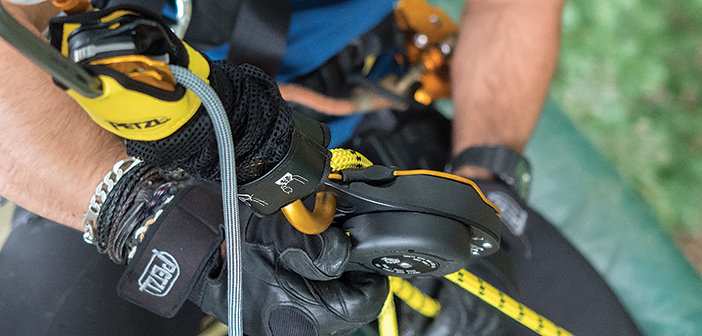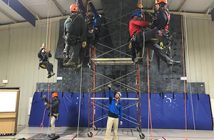By Patrick Ferebee, Director of Ecommerce and Product Strategy, Aerial Adventure Tech
If you are an aerial adventure or climbing gym operator, you have likely heard rumblings about the need for OSHA (Occupational Safety and Health Administration) compliance and thought, “Why do I care, and where should I begin?” There is a lot packed into this conversation, and our goal is to begin to shed light on this nuanced topic.
Here are the top 9 things you should know when it comes to OSHA compliance for your operation:
- OSHA Compliance is Law
- OSHA Compliance is the Employer’s Responsibility
- OSHA Isn’t Just Concerned with Work-at-Height
- Start with a Hazard Analysis
- Personal Protective Equipment (PPE) is a Last Resort
- Don’t Forget Rescue Plans for Staff
- Documentation Is Important
- OSHA Inspections Can Be Proactive and Low Consequence
- Educational Opportunities Exist
Now let’s break these down.
1. OSHA Compliance Is Law
Most organizations are aware of this, but do not act accordingly. Your business is probably diligent with documentation and compliance concerning other laws that affect it, such as tax law or labor laws. But for some reason, many adventure-based organizations see OSHA compliance as low priority and give it passing attention. In addition to the obvious ethical obligation to protect your employees from harm, there is serious financial risk to your business if found to be non-compliant with OSHA regulations. The less serious categories of violations have a maximum penalty of just over $13,000 per citation. Willful or repeated violations are capped at $132,598, with even higher fines and criminal conviction possible. Maybe it’s time you bump OSHA compliance up on your priority list?
2. OSHA Compliance Is the Employer’s Responsibility
It’s easy to assume that the professionals you hire to design, install, train, and maintain your facility are paying attention to all of your OSHA compliance needs. While your service provider is expected (and often required by standard) to provide you with products and services that comply with relevant municipal, state, and federal laws, the provider is not the entity ultimately liable for OSHA violations. Your vendors, as qualified professionals, are great resources, and you should tap them for advice and instruction whenever possible. But the documentation, training, and refinement of your employee safety program falls on you, the employer.
3. OSHA Isn’t Just Concerned with Work-at-Height
While fall protection violations are the most cited violations over the past 6 years (note that hazard communication is second in most years), OSHA is generally concerned with the health and safety of workers. OSHA standards cover everything from signage and sanitation to first aid and hazardous substances. So there might be a variety of OSHA standards to consider, such as when, say, an employee is applying chemical weed control on your property. Comb the standards and ensure the proper policies, procedures, documentation, and protective measures are in place for each aspect of your operation.
4. Start with a Hazard Analysis
You might have heard these called by a few names: Job Hazard Analysis (JHA), Risk Assessment, Hazard Assessment and Identification. Hazard analyses are the first critical step in making hazards transparent to employees and implementing the proper controls to protect them. Hazard analyses are even a worthwhile exercise for hazards your participants may encounter.
5. Personal Protective Equipment (PPE) Is a Last Resort
PPE and safe work methods have dominated the conversation around OSHA compliance in both the climbing gym and aerial adventure industry—for good reason, as strides need to be made in that area. But in the hierarchy of controls for hazards, PPE is the last resort. PPE only protects the user wearing it, can never provide 100% protection, and even with specific training always has the potential for user error. Based on your hazard analysis, assess where you can minimize and eliminate risk before deciding what PPE is necessary.
6. Don’t Forget Rescue Plans for Staff
OSHA requires that a rescue plan (or Emergency Action Plan) be in place for employees working-at-height and that they receive practical training on these procedures. Pretty much every operation has a rescue plan in place for their participants (even if it is just to call the fire department). Have you accounted for the rescue of a staff member, though? Work through the worst-case scenarios: an unconscious worker suspended on rope while routesetting; an employee that has taken a fall and deployed their energy absorber; a lead guide on a canopy tour that is unresponsive on a distant platform; or whatever scenarios present themselves at your site.
7. Documentation Is Important
Documentation often comes up as an afterthought, when in reality it should be your first step. A hazard analysis gets things started, but there are other requirements based on your type of business. For example, you will likely be required to identify all necessary PPE for employees, certify that the PPE has been provided to them at no expense, and that employees have received training in how to utilize it. Additional documentation may include Emergency Action Plans, blood-borne pathogen exposure programs, and work-related injury and illness logs.
It is critical to understand what documentation is necessary and the requirements to retain those documents over time. Remember that documentation is evidentiary, so whether required by law or not, it can be used by OSHA for regulatory citations. We recommend reaching out to an OSHA expert who can evaluate your business activities and outline the specific documentation requirements for it.
8. OSHA Inspections Can Be Proactive and Low Consequence
OSHA is not some nagging entity that is just out to fine your business and make life hard. Their mission is to protect the health and safety of workers, and OSHA staff are available to help you find gaps at your site or interpret standards. Very often, you can contact a local inspector and ask him to audit your operation. OSHA inspectors do this free of charge and offer a list of infractions to remedy. Doing this can both familiarize your regional OSHA office with the unique aspects of our industries and allow you time to resolve compliance gaps before an unannounced inspection or employee incident.
9. Educational Opportunities Exist
This world is admittedly hard to navigate, and the push for compliance is fairly nascent in our respective industries, even though compliance has been necessary all along. Resources and formal training do exist, with some info being easier to digest and interpret than others. Here are some places to get started:
Standards and Expanded Resources
OSHA
1926 Standards – Construction
OSHA
1910 Standards – General Industry
OSHA Summary of Fall Protection Standards for Non-Construction
OSHA Pamphlet on Protecting Zip Line Workers
ASTM, ACCT, PRCA, and CWA all approach requirements
for employees in varying degrees, so look for us to unpack that in a later article.
Additionally, we will talk
more about the roles of ANSI standards and testing in later articles.
Books
North American Working at Height Handbook
This
handy field book was developed by leading companies in the work-at-height world
and is definitely the most digestible resource out there. We recommend every location
have this on their bookshelf, and every industry pro own a copy. While is doesn’t
necessarily address every aspect of OSHA compliance, if you work through the recommendations
in this book you’ll be well on your way.
Training
OSHA
Training Requirements and Resources
To
assist with your in house trainings and a quick reference on what standards require
training be given.
OSHA
Outreach Training Program
Receive OSHA certified training with basic and advanced options available.
Learn more about OSHA-compliant PPE at www.aerialadventuretech.com.






